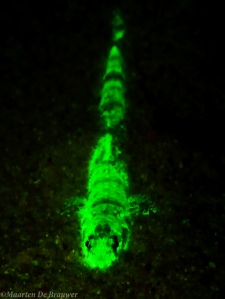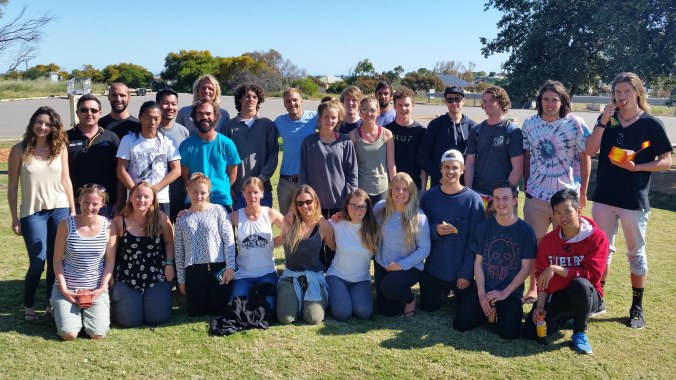Last week I’ve had the pleasure of exploring a new, beautiful area of Western Australia: Coral Bay in the Ningaloo Marine Park. I wasn’t visiting just for fun, but went over to tutor during a marine field project for the third year marine science students of Curtin University. The goal of the course is to get marine science students hands-on experience with working in the field. To achieve this, the students worked in groups of 4 on a research project of their choice, with a bit of help from their lecturers (and tutors). As I have written earlier, there are a few very good and a few very bad reasons to want to become a marine biologist. This link is another great write-up for people considering to become a marine biologist. So besides being very keen to help with training a new generation of marine scientists, I was also rather curious to find out more about these people keen to trade civilised comfort for sunburns, sandy beds and soaking in salt water for hours on end.

Coral Bay
The 23 students taking the course were a diverse bunch, but they all share a passion for the ocean. To my great relief, most of them actually seemed interested in science and real marine ecosystems, and not just in hugging dolphins (=the WORST reason for anyone to consider becoming a marine biologist). Or maybe they just didn’t dare to admit it in front of me? Regardless of what motivated them, before I even got on the bus with them for the long drive (15 hours) to Coral Bay, they had already spent a few weeks preparing their research projects. The projects were diverse, with groups looking at topics like coral cover, parrotfish abundance, sediments, fish diversity, etc. None of the groups was looking at my kind of critters, but that only meant I would get to learn a few new things myself as well.

Student ready to survey fish
After arriving late at night in Coral Bay, the daily schedule was for students to go out to do fieldwork by day, and to come back to the research station in the afternoon to enter their data and analyse videos where possible. The tutors (Ash and me) were mostly expected to chill out on the beach to make sure nobody drowned, join students in the water to help where possible and answer any practical questions the students might have. As is usually the case with fieldwork, especially when you are new to it, getting started isn’t always easy. Regardless of what you are surveying in the ocean, you will need a fair bit of equipment, ranging from slates, to GPS’s, measuring tapes, plastic bags, cameras, quadrats, etc. Understandably, one of the main issues in the first days was forgetting to bring crucial pieces of equipment to the site, or loosing equally crucial equipment in the water (sometimes never to be found again). Identifying fish and corals is also more challenging once you are in the water than what you’d imagine it to be while preparing your project. But as the week went on, the groups started to find their rhythm, got more confident and grew enthusiastic about getting results. That feeling of collecting real data is always a great one. The next step for the students now they’re back in Perth is to analyse their data and write their results up into a research paper. Which makes this project a great practice for other, more serious research projects they might do in the future.

Nikki staining corals
While the students were working away on their projects, I was also helping out my colleague tutor and PhD-candidate Ash. Her work looks at the effects of climate change, and as part of her research she will be collecting environmental data from all around Western Australia. This week she was testing her brand new, high-tech in-situ CO2 sensor. I imagined it would be as easy as chucking out an anchor in the ocean, but turns out it involves a fair bit more thinking and crafty tinkering to deploy the unit successfully. I also gave Nikki (the unit coordinator) a hand staining corals, a technique that is used to measure growth rates of coral. I had hardly done any work with corals before, so it was great to learn something new and see how coral scientists spend their days in the field.

Biofluorescing Lizardfish
I even had time to go for a cheeky night-snorkel for myself to check out biofluorescence in the bay. Turns out there is quite a lot going on! Mostly coral showing green fluorescence, which seemed brighter than many locations I’d checked fluorescence previously. In the shallow, sandy areas there were loads of lizardfish and goatfish, and even a few bright green nudibranchs. It was interesting that during the snorkel I didn’t see any other fluo colours than green, compared to the mix of green, yellow, orange and red I got used to seeing in Southeast Asia. The question of why this is the case remains a mystery to me…
Looking back at this week, I am very happy I got the chance to join the field trip. From a personal point of view I got some great experience teaching and guiding students, I learned a few new research methods in the water, all of that while staying in a gorgeous location. Most of all though, I enjoyed helping out with the education of new marine scientists. It is great to see motivated students find their way in the field and grow confident and enthusiastic about the work they are doing, and I am honoured to be able to help out with it. I don’t know which direction they will go after graduating, but it would be good to see at least a few of them as colleagues in the future. I wish them all the best, and hope they enjoyed the trip as much as I did.
